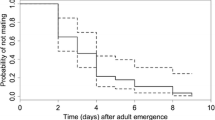Abstract
Field trapping of the American palm weevil (APW),Rhynchophorus palmarum, showed that the combination of caged male APWs and palm stem was much more attractive to APWs of both sexes than palm stem alone. Caged female APWs did not enhance the attractiveness of the palm. Caged APWs without palm stem were not attractive. Virgin laboratory-bred males were highly attractive to APWs of both sexes in a two-choice pitfall olfactometer, whereas virgin laboratory-bred females were not. Adsorbenttrapped volatiles from virgin laboratory-bred males reproduced the effect of living males, giving evidence for a male-produced aggregation pheromone in this species. Wild-mated APWs of both sexes were as responsive to the aggregation pheromone as virgin laboratory-bred APWs. This is the first record of chemical communication in this species. These results have prompted investigations into the chemical identification of the aggregation pheromone.
Similar content being viewed by others
References
Blight, M.M., andWadhams, L.J. 1987. Male-produced aggregation pheromone in pea and bean weevil,Sitona lineatus (L.).J. Chem. Ecol. 13:733–739.
Borden, J.H. 1985. Aggregation pheromones, pp. 257–285,in G.A. Kerkut and L.I. Gilbert (eds.). Comprehensive Insect Physiology, Biochemistry and Pharmacology, Vol. 9. Pergamon Press, Oxford.
Borden, J.H., Dolinski, M.G., Chong, L., Verigin, V., Pierce, H.D., Jr., andOehlschlager, A.C. 1979. Aggregation pheromone in the rusty grain beetle,Cryptolestes ferrugineus (Coleoptera: Cucujidae).Can. Entomol. 111:681–688.
Dagnelie, P. 1975. Théorie et méthodes statistiques, applications agronomiques, Vol. 2. Les presses agronomiques de Gembloux, Belgium, pp. 107–252.
Dumortier, B. 1963. Morphology of sound emission apparatus in Arthropoda, pp. 277–304,in R.G. Busnel (ed.). Acoustic Behaviour of Animals. Elsevier, Publishing Co., Amsterdam.
Faustini, D.L., Giese, W.L., Phillips, J.K., andBurkholder, W.E. 1982a. Aggregation pheromone of the male granary weevil,Sitophilus granarius (L.).J. Chem. Ecol. 8:679–687.
Faustini, D.L., Rowe, J.R., andBurkholder, W.E. 1982b. A male-produced aggregation pheromone inTribolium brevicornis (Leconte) (Coleoptera: Tenebrionidae) and interspecific responses of severalTribolium species.J. Stored Prod. Res. 18:153–158.
Genty, P., Desmier de Chenon, R., andMorin, J.P. 1978. Les ravageurs du palmier a huile en Amérique Latine.Oléagineux 33:325–419.
Giblin-Davis, R.M., Gerber, K., andGriffith, R. 1989. Laboratory rearing ofRhynchophorus cruentatus andR. palmarum (Coleoptera: Curculionidae).Fla. Entomol. 72:480–488.
Griffith, R. 1968. The relationship between the red ring nematode and the palm weevil.J. Agric. Soc. Trin. Tob. 68:342–356.
Griffith, R. 1987. Red ring disease of coconut palm.Plant Dis. 71:193–196.
Hagley, E.A.C. 1965. On the life history and habits of the palm weevil,Rhynchophorus palmarum. Ann. Entomol. Soc. Am. 58:22–27.
Hardee, D.D., Mitchell, E.B., andHuddleston, P.M. 1967. Procedure for bioassaying the sex attractant of the boll weevil.J. Econ. Entomol. 60:169–171.
Haskell, P.T. 1974. Sound Production, pp. 353–410,in M. Rockstein (ed.). The Physiology of Insecta, Vol. 2, 2nd ed. Academic Press, New York.
Lepesme, P., Ghesquière, J., Bourgogne, J., Cairaschi, E., Paulian, R., andVilliers, A. 1947. Les insectes des palmiers. Paul Lechevalier, Paris, pp. 611–617.
Lucchini, P., andMorin, J.P. 1985. Estudos e controle deRhynchophorus palmarum (L.) em dendê no Estado de Bahia, Manaus. Relatorio de projecto de pesquisa, EMBRAPA/CNPSD. 15 pp.
Mariau, D. 1968. Méthodes de lutte contre le Rhynchophore.Oléagineux 23:443–446.
Meksongsee, B., andSakulpanich, U. 1975. Field study of trapping coconut weevil,Rhynchophorus vulneratus (Panzer), with sex attraction. 4th Session of the FAO technical working party on Coconut production, protection and processing. Kingston Jamaica, September 14–25, 1975. 5 pp.
Morin, J.P., Lucchini, F., Araujo, J.C., Ferreira, J.M., andFraga, L.S. 1988. Le contrôle deRhynchophorus palmarum par piégeage à l'aide de morceaux de palmier.Oléagineux 41:57–59.
Nadarajan, L. 1984. Studies on trapping the palm weevil,Rhynchophorus phoenicis F. pp. 12–38,in Coconut and Oil Palm Entomology, Training report, IRHO, Abidjan, Ivory Coast.
O'Ceallachain, D.P., andRyan, M.F. 1977. Production and perception of pheromones by the beetleTribolium confusum.J. Insect Physiol. 23:1303–1309.
Payne, T.L., Hart, E.R., Edson, L.J., McCarty, F.A., Billings, P.M., andCoster, J.E. 1976. Olfactometer for assay of behavioral chemicals for the southern pine beetle,Dendroctonus frontalis (Coleoptera: Scolytidae).J. Chem. Ecol. 2:411–419.
Phillips, J.K., andBurkholder, W.E. 1981. Evidence for a male-produced aggregation pheromone in the rice weevil.J. Econ. Entomol. 74:539–542.
Pierce, A.M., Borden, J.H., andOehlschlager, A.C. 1981. Olfactory response to beetle-produced volatiles and host-food attractants byOryzaephilus surinamensis andO. mercator.Can. J. Tool. 59:1980–1990.
Restrepo, G.L., Rivera, A.F., andRaigosa, B.J. 1982. Ciclo de vida, hábitos y morfometna deMetamasius hemipterus Olivier yRhynchophorus palmarum L. (Coleoptera: Curculionidae) en caña de azucar (Saccharum officinarum L.).Acta Agron. Colombia 32:33–44.
Rochat, D. 1987. Etude de la communication chimique chez un Coléoptère Curculionidae:Rhynchophorus palmarum L. DEA report, Université Paris VI. 30 pp.
Rochat, D. 1990.Rhynchophorus palmarum L. (Coleoptera, Curculionidae): Nuevos datos sobre el comportamiento del insecto y su control por trampeo olfactivo. Perspectivas.Palmas 10:69–79.
Rudinsky, J.A., andRyker, L.C. 1977. Olfactory and auditory signals mediating behavioral patterns of bark beetles.Coll. Int. C.N.R.S. 265:195–207.
Siegel, S. 1956. Nonparametric Statistics for the Behavioral Sciences. McGraw-Hill, New York. 312 pp.
Walgenbach, C.A., Phillips, J.K., Faustini, D.L., andBurkholder, W.E. 1983. Male-produced aggregation pheromone of the maize weevil,Sitophilus zeamais, and interspecific attraction between threeSitophilus species.J. Chem. Ecol. 9:831–841.
Wilson, M.E. 1963. Investigations into the development of the palm weevilRhynchophorus palmarum (L.).Trop. Agric. Trin. Tob. 40:185–196.
Author information
Authors and Affiliations
Rights and permissions
About this article
Cite this article
Rochat, D., González, A.V., Mariau, D. et al. Evidence for male-produced aggregation pheromone in American palm weevil,Rhynchophorus palmarum (L.) (Coleoptera: Curculionidae):. J Chem Ecol 17, 1221–1230 (1991). https://doi.org/10.1007/BF01402945
Received:
Accepted:
Issue Date:
DOI: https://doi.org/10.1007/BF01402945




